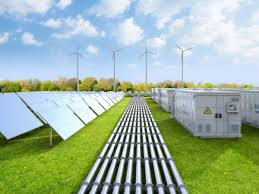India’s ‘green’ power capacity overtakes thermal: Why it matters, the challenges posed, and what’s next

India has reached a significant turning point in its energy journey: for the first time ever, the country’s installed power capacity from non-fossil fuel sources has surpassed thermal power. As of June 30, 2025, more than 50% of India’s installed electricity capacity now comes from renewable sources like solar, wind, hydro, and nuclear. This achievement comes five years ahead of the country’s 2030 Paris Agreement target, marking a major milestone in the global fight against climate change.
But while the headlines celebrate this progress, the real picture is more nuanced. Clean capacity doesn’t automatically translate to clean energy generation, and India’s energy transformation is just beginning.
Why This Milestone Is Important
This shift toward green power is not just symbolic. It demonstrates India’s serious commitment to climate goals and highlights how rapidly renewable technology has advanced. Over the past decade, India has added solar parks, wind farms, and large hydropower projects at an unprecedented pace.
Key benefits of this shift include:
- ✅ Reduced dependence on fossil fuels: With more clean power capacity, India can slowly wean itself off coal, which currently accounts for over 65% of the country’s electricity generation.
- ✅ Enhanced energy security: Unlike coal or gas, renewable energy sources are indigenous. Solar and wind power reduce the need to import fuels, saving foreign exchange.
- ✅ Global climate leadership: Achieving the 50% capacity target early puts India in a strong position at international climate negotiations. It enhances India’s image as a proactive country in combating climate change.
The Ground Reality: Generation vs. Capacity
Although renewables now lead in terms of installed capacity, coal still dominates actual electricity generation. This discrepancy exists because solar and wind power are intermittent—they don’t produce electricity 24/7.
In 2024 alone, coal generated over 1,500 terawatt-hours (TWh) of electricity, while all renewable sources combined contributed just over 240 TWh. In short, India still relies heavily on coal to meet rising electricity demand, especially during peak hours and seasonal fluctuations.
Major Challenges Ahead
1. Inconsistent Power Supply from Renewables
Solar and wind energy are weather-dependent. Cloudy days, lack of wind, or seasonal shifts can reduce power generation. This unpredictability means India needs to invest heavily in battery storage and grid stability mechanisms to make green energy reliable.
2. Storage and Infrastructure Bottlenecks
India is still in the early stages of deploying large-scale energy storage solutions. Without adequate storage, excess solar power during the day cannot be used at night. Additionally, the national grid requires significant upgrades to handle the fluctuating load from renewables.
3. Continued Coal Expansion
Despite the rise of renewables, India is still building new coal plants. Government projections indicate an addition of 80–90 GW of coal-based capacity by 2032. This expansion is partly due to energy security concerns and the need for round-the-clock power supply in a rapidly developing economy.
4. Financial Stress on Power Distribution Companies
India’s power distribution companies (Discoms) are often financially unstable. They struggle with overdue payments and are hesitant to sign new renewable energy purchase agreements. Without a healthy financial backbone, the entire renewable sector could suffer delays.
5. Policy and Regulatory Uncertainty
Frequent changes in solar tariffs, taxation issues on imported modules, and investigations into bidding practices have caused market anxiety. Consistent and transparent policies are needed to attract long-term investment.
What’s Next for India’s Green Energy Journey?
Despite the hurdles, India is poised to scale new heights in clean energy. Here’s what to expect in the coming years:
🔋 Accelerated Energy Storage Development
India plans to invest over ₹50,000 crore in energy storage solutions, including battery manufacturing under the Production-Linked Incentive (PLI) scheme. This will help stabilize the grid and enable renewable power to serve round-the-clock needs.
🔌 National Grid Modernization
Efforts are underway to enhance India’s transmission infrastructure. The goal is to create a ‘One Nation, One Grid’ system that allows renewable power from resource-rich states like Rajasthan or Tamil Nadu to reach demand hubs across the country.
🏭 Gradual Coal Retirement
Older, inefficient coal plants are being retired. Simultaneously, flexible coal plants are being developed to act as backup to renewables. This hybrid model will be crucial in maintaining stability while reducing emissions.
💼 Policy Reforms to Strengthen Discoms
The central government is pushing reforms to make power distribution more efficient and accountable. Smart meters, prepaid billing, and reduction of aggregate technical and commercial losses are all on the agenda.
🌍 Global Collaboration and Investment
India is already working closely with global partners on clean energy technologies. International initiatives like the International Solar Alliance (ISA) and collaboration with the U.S., EU, and Japan are expected to bring in more technology and financing.
Final Thoughts
India’s achievement of surpassing thermal power capacity with green alternatives is a major step forward. However, the real transformation lies in ensuring that this capacity actually delivers clean, reliable, and affordable power to every corner of the country.
The path ahead will require coordinated efforts in policy, investment, innovation, and infrastructure. If India succeeds, it won’t just be a win for the country—but a beacon of hope for the entire planet striving for a cleaner, greener future.






